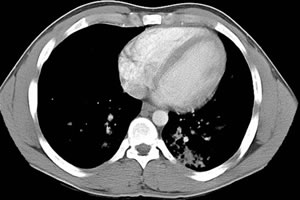Background
Drowning (Utstein definition) is a process resulting in primary respiratory impairment from submersion/immersion in a liquid medium.
Drowning is often the result of an underlying event or condition that contributes to unintentional immersion or immersion with incapacitation, such as trauma, intoxication, seizure, hypothermia, dysrhythmia, shallow-water blackout, and, for divers, a lost or improper breathing source. It is important to search for and treat any underlying triggering factors / complications.
Drowning in children is usually accidental.
- The term near-drowning is not used
- There is no clinically significations difference between salt and fresh water immersion
- The most important prognostic factors are the duration and severity of the hypoxia
Initial treatment
The most important and detrimental consequence of submersion is hypoxia. Therefore, oxygenation, ventilation, and perfusion should be restored as rapidly as possible (immediate bystander CPR). Victims who have spontaneous circulation and breathing when they reach the hospital usually recover with a good outcome.
- All patients who require any form of resuscitation (including rescue breathing alone) should be transported to the Emergency Department (delayed onset pulmonary oedema)
In Cardiac Arrest
- The most important treatment of the drowning victim is the immediate provision of ventilation
- If in cardiac arrest - no modification of standard BLS sequencing is necessary
- Continue standard ACLS, including early intubation
- Routine stabilization of the spine is not necessary unless there is a definite history of trauma (e.g. diving)
- There is no need to clear the airway of aspirated water (any small amount is rapidly absorbed)
- The routine use of abdominal thrusts (or Heimlich manoeuvre) is not recommended
- Beware of hypothermia (may be neuroprotective) particularly if water <5°C
- ILCOR recommendations support the use of therapeutic hypothermia in patients who remain in a coma after resuscitation from cardiac arrest caused by VF and note that it may be effective for other causes of cardiac arrest but
- There is insufficient evidence to support or refute the use of therapeutic hypothermia after return of spontaneous circulation (MJA case report) in drowning victims
Not in Cardiac Arrest
History
- Please note mechanism of injury (diving etc) and submersion time
- Respiratory, GI and neurological symptoms
- Coincidental substance abuse
- Past medical history
Examination
- Full physical exam (particular attention to respiratory, cardiovascular and neurological systems)
- Pulmonary oedema is usually seen within 4 hours but may be delayed (beware tachypnoea)
- Check temperature
- Consider triggering pathology (epilepsy, AMI, neurological event, endocrinopathy)
- Beware NAI in toddlers (bathtub drownings usually)
Investigations

- ABG (incl. lactate), U&E, Coag only if indicated
- Save serum for later toxicology analysis
- Trauma series if appropriate history
- Head CT if unconscious or altered mental status
Management
- Aggressive airway management (hypoxia is the most important factor) with early RSI if necessary
- Use PEEP if intubated
- CPAP if mild hypoxia and not suitable for intubation
- Beware "silent" bronchospasm
- Prolonged resuscitation is likely to carry a poor outcome if the factors below exist:
- Asystole
- Submersion > 10 min
- Severe hyperkalaemia
- Actively manage hypothermia (advice here)
- Routine use of IV steroids is not indicated [BestBets]
- There is no evidence to support the use of prophylactic antibiotics [Bestbets]
- Intubated patients require 24 hours ventilation (beware ARDS)
- If the patient is recovering well, they can be closely monitored (particularly resp. rate & pulse oximetry) in an ED observation area
- Patients in ED who are asymptomatic and alert (normal vital signs incl. resp. rate and pulse oximetry) do not requier any invasive investigations but should be observed for 8 hours (risk bronchosapasm or pulmonary oedema). Please check ECG (e.g. LQTS / AMI) in all
- Consider CT Cervical spine if trauma (especially diving) or require a CT brain
- Consider NAI (incl. neglect), DSH/DSP and medical social worker referral
links
Crowe S, Mannion D, Healy M, O’Hare B. Paedatric near-drowning: mortality and outcome in a temperate climate. Irish Medical Journal 2003; 96(9):274-276.